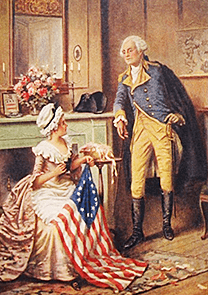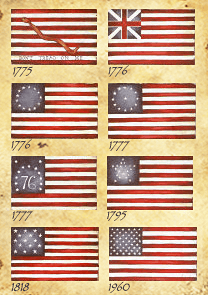U.S. Flag History & Information

Beginnings of the American Flag
The flag of the United States of America has storied beginnings. The first official flag of what came to be our United States was the “Continental Colors” flag, which featured the stripes that are familiar to us, but had the British Union in place of the stars. The “Betsy Ross” flag is a highly debated topic among Americans and Vexillologists (those who study flags) alike, as there is circumstantial evidence that links Betsy Ross to the flag, but nothing concrete. Either way, the first “13 Star” flag with five-pointed stars in an equal circle was first hoisted in June 1777.


Progression of the American Flag
The number of American States grew, as did the number of stars of the American Flag, which led to some unique organizations of those stars. Even with the number of stars slowly growing from 13 to our present day of 50, the number of stripes has never changed.
The American Flag as a Symbol
The American Flag is easily the most recognized flag internationally, and while most people would relate the Bald Eagle as the chief symbol of the United States, the flag is more significant. The American Flag represents freedom, justice, and the struggle of the oppressed colonists who rebelled against an unjust ruling nation. The flag is indicative of the spirit that embodies all free people to have free will.
The American Flag Today
When Alaska and Hawaii were being considered for statehood in the 1950s, more than 1,500 designs were spontaneously submitted to President Dwight D. Eisenhower. Although some of them were 49-star versions, the vast majority were 50-star proposals. Of these proposals, one created by 17-year-old Robert G. Heft in 1958 as a school project received the most publicity. Heft’s flag design was chosen and adopted by presidential proclamation after Alaska and before Hawaii was admitted into the Union in 1959. Both the 49 and 50 star flags were each flown for the first time ever at Fort McHenry on the Fourth of July one year apart, 1959 and 1960 respectively.

H.R. 42 (109th): Freedom to Display the American Flags Act of 2005
To learn more about this act, please visit https://www.govtrack.us/congress/bills/109/hr42/text.
DEFINITIONS
For purposes of this Act–
- the term `flag of the United States’ has the meaning given the term `flag, standard, colors, or ensign’ under section 3 of title 4, United States Code;
- the terms `condominium association’ and `cooperative association’ have the meanings given such terms under section 604 of Public Law 96-399 (15 U.S.C. 3603);
- the term `residential real estate management association’ has the meaning given such term under section 528 of the Internal Revenue Code of 1986 (26 U.S.C. 528); and
- the term `member’–
- as used with respect to a condominium association, means an owner of a condominium unit (as defined under section 604 of Public Law 96-399 (15 U.S.C. 3603)) within such association;
- as used with respect to a cooperative association, means a cooperative unit owner (as defined under section 604 of Public Law 96-399 (15 U.S.C. 3603)) within such association; and
- as used with respect to a residential real estate management association, means an owner of a residential property within a subdivision, development, or similar area subject to any policy or restriction adopted by such association.
RIGHT TO DISPLAY THE FLAG OF THE UNITED STATES
A condominium association, cooperative association, or residential real estate management association may not adopt or enforce any policy, or enter into any agreement, that would restrict or prevent a member of the association from displaying the flag of the United States on residential property within the association with respect to which such member has a separate ownership interest or a right to exclusive possession or use.
LIMITATIONS
Nothing in this Act shall be considered to permit any display or use that is inconsistent with–
- any provision of chapter 1 of title 4, United States Code, or any rule or custom pertaining to the proper display or use of the flag of the United States (as established pursuant to such chapter or any otherwise applicable provision of law); or
- any reasonable restriction pertaining to the time, place, or manner of displaying the flag of the United States necessary to protect a substantial interest of the condominium association, cooperative association, or residential real estate management association.
Flag Care Tips
HOW TO CARE FOR A FLAG
Over time, any outdoor flag will show signs of wear and tear. With reasonable care, the effects of wind, water, sun, and dirt can be minimize to extend the life of the flag. Nylon and cotton flags are generally expected to last around 3 months (90 days). Studies have shown that the lifespan of flags flown 24 hours a day is approximately one fourth of what is expected. Some people may replace the flag as soon as it shows signs of damage, but it is possible to make unnoticeable repairs to the flag, allowing it to fly high and beautiful- as long as it looks undamaged. For beauty and longevity- we recommend keeping two flags, and rotating them throughout the year.
THE DO’S & DON’TS OF FLAG CARE:
- Do repair the flag at the first sign of fraying before further damage is done
- Do gently wash the flag in cool water with mild detergent
- Do line or flat dry thoroughly- in order to prevent mildew
- Do store the flag in a well-ventilated are
- Do iron the flag with the appropriate heat setting to remove wrinkles
- Do Not roll up, fold, store, or otherwise crease a wet flag
- Do Not expose the flag to unfavorable or inclement weather (extreme winds, heavy rain, snow)
HOW TO CLEAN YOUR FLAGS:
If your flag is made of a synthetic material such as nylon or polyester:
- Use a brush to remove any loose layers of dirt.
- Place it in the washing machine without any other articles of clothing.
- Put a mild detergent in (no softeners!).
- Wash on cold and use your delicate cycle.
- Don’t put it in the dryer! Instead, hang it to dry or lay it flat on a table. Wrinkles can be removed with a cool iron.
If your flag is made of natural material such as wool or cotton:
- Shake your flag gently to remove any loose layers of dirt.
- Fill a tub or large plastic container with lukewarm water and a standard amount of oxygen-based bleach.
- Place the flag under the water and let it soak. Leave it for 4 hours or longer, depending on how dirty it is.
- Once satisfied, rinse the flag in cold water.
- Hang it or lay it flat to dry. If there are wrinkles, use a hot iron to get them out.
OUTDOOR FLAG CARE
Unless properly lit, flags should only be flown during the day time- in appropriate weather. This is in accordance with USA Government. For your flagpole lighting needs, we recommend using the Flagpole Beacon©.
INDOOR FLAG CARE
Dry cleaning is recommended for Indoor Flags. In the months of June and July, some dry cleaners offer free flag cleaning services, so be sure to check your area.
PROPER FLAG DISPOSAL
Extremely torn or frayed flags should be disposed of properly- in accordance with the U.S. Flag Code.
Flag Size Variability
All flags vary a bit in size, but especially in the 3’x5’ size, there is quite a bit of variability due to the production process. A true 3’x5’ exact (or other exact size flag) is a custom flag.
The G-Spec (Government Specification) nylon flags are in the following sizes; these have a tolerance of less than an inch in any direction:
Note – the 5’x 9.5’ is a Casket Flag